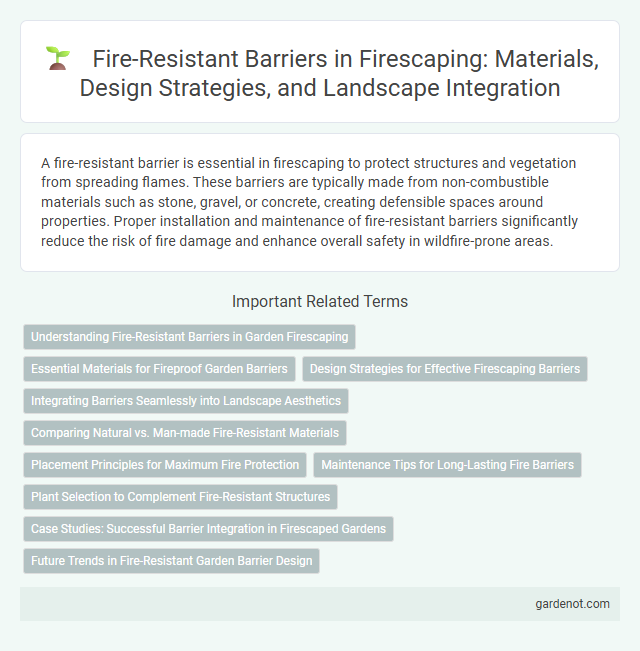A fire-resistant barrier is essential in firescaping to protect structures and vegetation from spreading flames. These barriers are typically made from non-combustible materials such as stone, gravel, or concrete, creating defensible spaces around properties. Proper installation and maintenance of fire-resistant barriers significantly reduce the risk of fire damage and enhance overall safety in wildfire-prone areas.
Understanding Fire-Resistant Barriers in Garden Firescaping
Fire-resistant barriers in garden firescaping are essential for preventing the spread of wildfires by creating defensible spaces around properties. These barriers often include non-combustible materials such as stone, gravel, and fire-resistant plants that reduce fuel availability. Proper installation and maintenance of fire-resistant barriers significantly enhance landscape resilience and protect homes from fire damage.
Essential Materials for Fireproof Garden Barriers
Fire-resistant barriers in gardens rely on essential materials such as non-combustible stone, brick, and concrete blocks, which prevent flame penetration and reduce heat transfer. Specialized fire-resistant cement and treated metal mesh enhance structural integrity while withstanding high temperatures. Incorporating these materials into firescaping designs significantly improves safety by creating reliable firebreaks around vegetation and structures.
Design Strategies for Effective Firescaping Barriers
Effective firescaping barriers incorporate fire-resistant materials such as fiber cement, stucco, or stone to minimize ignition risks. Strategic placement of these barriers around structures blocks wildfire embers and radiant heat, reducing fire intensity near vulnerable areas. Integrating defensible space principles with fire-resistant landscaping enhances overall protection and resilience against fire spread.
Integrating Barriers Seamlessly into Landscape Aesthetics
Fire-resistant barriers composed of non-combustible materials such as stone, brick, or metal can be integrated seamlessly into landscape aesthetics by matching textures and colors with natural elements and existing structures. Utilizing earth-toned retaining walls, gravel paths, or decorative metal screens provides effective fire protection while maintaining visual harmony. Strategic placement of these barriers around vulnerable zones enhances fire resilience without disrupting the overall design flow of outdoor spaces.
Comparing Natural vs. Man-made Fire-Resistant Materials
Natural fire-resistant materials such as stone, clay, and adobe offer eco-friendly, sustainable options with inherent thermal mass properties that slow heat transfer during wildfires. Man-made alternatives including gypsum boards, cementitious panels, and intumescent coatings provide engineered solutions with consistent fire ratings and customizable thicknesses for enhanced protection. Evaluating factors like durability, cost-effectiveness, and environmental impact is crucial when selecting between natural and synthetic fire-resistant barriers in firescaping projects.
Placement Principles for Maximum Fire Protection
Strategic placement of fire-resistant barriers is critical for maximizing fire protection around structures, primarily by isolating potential fuel sources and preventing fire spread. Barriers should be installed at vulnerable points such as roof edges, eaves, vents, and where vegetation is dense, ensuring the continuity of protection. Utilizing fire-resistant materials with proper sealing and maintaining clearance zones significantly enhances the barrier's effectiveness against radiant heat and ember intrusion.
Maintenance Tips for Long-Lasting Fire Barriers
Regular inspection and prompt repair of fire-resistant barriers ensure their integrity and effectiveness over time. Use appropriate sealants and fire-retardant coatings to maintain barrier performance against heat and flames. Clear debris and maintain proper ventilation to prevent moisture buildup that can degrade fire-resistant materials.
Plant Selection to Complement Fire-Resistant Structures
Selecting fire-resistant plants such as succulents, firs, and manzanitas enhances the effectiveness of fire-resistant barriers by reducing combustible materials near structures. These species possess high moisture content and minimal resin, lowering fire ignition risk and promoting landscape resilience. Integrating strategic plant placement around fire-rated walls strengthens overall defense against wildfire exposure.
Case Studies: Successful Barrier Integration in Firescaped Gardens
Case studies of fire-resistant barriers in firescaped gardens demonstrate their effectiveness in reducing wildfire risk through strategic placement and material choice. Integrating non-flammable materials like stone, brick, and concrete along garden perimeters creates defensible spaces that slow fire spread and protect vegetation. These real-world examples highlight tailored design approaches that balance aesthetics with safety, resulting in resilient landscapes that withstand wildfire exposure.
Future Trends in Fire-Resistant Garden Barrier Design
Fire-resistant garden barriers are evolving with the integration of advanced materials like intumescent coatings and fire-retardant composites to enhance safety and durability. Innovations in smart sensor technology enable real-time fire detection and barrier activation, significantly reducing fire spread risks. Sustainable design trends emphasize eco-friendly, non-toxic materials that provide effective protection while minimizing environmental impact.
Fire-resistant barrier Infographic

 gardenot.com
gardenot.com